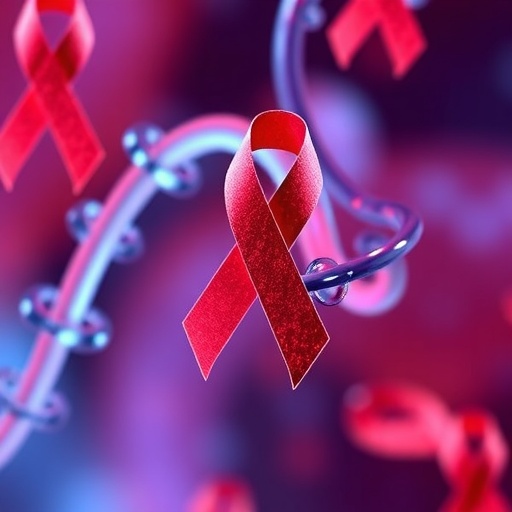
In a groundbreaking development in the fight against HIV, researchers at Johns Hopkins Medicine have unveiled a novel approach that could revolutionize the treatment of the virus by inducing a long-term dormant state within infected cells. This innovative strategy revolves around harnessing a unique molecule produced by HIV itself, known as the antisense transcript (AST), to enforce viral latency and prevent replication. The implications of this research are profound, offering a possible pathway toward lasting control of the virus without the need for continuous antiretroviral therapy.
The concept of viral latency in HIV infection has long been a significant barrier to curing the disease. HIV integrates its genetic material into host immune cells, particularly CD4+ T cells, where it can lie dormant for extended periods. During latency, the virus does not produce new copies of itself, evading both immune detection and antiviral drugs. The Johns Hopkins team, led by Dr. Fabio Romerio, focused on AST, a molecular transcript encoded by the HIV genome on the strand opposite to the one that produces viral proteins. AST appears to be part of a naturally occurring regulatory mechanism that restricts viral gene expression and maintains the virus in a silent state.
In their recent study, researchers genetically engineered HIV-infected CD4+ T cells to overexpress AST, adding a genetic element designed to amplify AST production within the cells. This manipulation led to a significant decline in viral transcriptional activity. They used green fluorescent protein (GFP) as a surrogate marker for HIV gene expression, observing that cells with elevated AST levels exhibited nearly undetectable GFP fluorescence, indicating deep viral dormancy. This finding underscores AST’s potential as a molecular switch to silence viral replication robustly and sustainably.
.adsslot_DhkbHOR2M1{width:728px !important;height:90px !important;}
@media(max-width:1199px){ .adsslot_DhkbHOR2M1{width:468px !important;height:60px !important;}
}
@media(max-width:767px){ .adsslot_DhkbHOR2M1{width:320px !important;height:50px !important;}
}
ADVERTISEMENT
Further molecular analysis focused on dissecting the structure-function relationships of the AST molecule. Utilizing advanced laser-based cytometry techniques, the team identified specific regions of AST critical for its ability to bind and recruit host proteins that enforce viral silencing. By creating a series of targeted mutations within the AST sequence, the researchers delineated domains essential for initiating and maintaining latency. These insights are pivotal for guiding the design of gene therapies that could specifically enhance the virus’s natural latency mechanisms.
Crucially, the study extended beyond laboratory-grown cell lines to examine the behavior of AST in CD4+ T cells derived from individuals living with HIV. These cells were transiently transfected with DNA encoding AST through a method that permeabilizes cell membranes, enabling direct delivery of genetic material. This approach proved successful in inducing viral latency, with HIV remaining dormant for at least four days post-treatment. The transient nature of AST expression, which declined as the introduced DNA fragmented, highlights the need for stable gene therapy methods to sustain this state in patients.
The biomedical significance of this research is heightened by the limitations of current antiretroviral therapies (ART). While ART effectively suppresses active viral replication, it does not eradicate the latent reservoir. Patients must adhere to lifelong medication regimens, which can lead to cumulative side effects and the risk of viral rebound if interrupted. The Johns Hopkins team’s vision is to develop a single-dose gene therapy strategy that boosts intrinsic viral latency pathways through AST, offering a durable functional cure and drastically reducing treatment burdens.
Mechanistically, the antisense transcript likely modulates chromatin remodeling and recruits epigenetic regulators to the integrated viral genome. This suppresses transcription of viral genes, maintaining the genome in a repressed configuration that prevents reactivation. Understanding this precise interplay between viral RNA transcripts and host cell machinery opens new doors for targeting HIV reservoirs that have traditionally been resistant to conventional therapies.
The research, which was funded primarily by the National Institutes of Health and supported by the American Foundation for AIDS Research, involved multidisciplinary collaboration among molecular biologists, immunologists, and clinicians. Alongside Drs. Fabio Romerio and Rui Li at Johns Hopkins, scientists from Massachusetts General Hospital and George Mason University contributed to refining the experimental approaches and validating the findings in patient-derived cells.
Looking forward, the integration of AST-based gene therapies into clinical practice will require overcoming significant hurdles, including efficient and safe delivery of genetic materials to patient immune cells, long-term expression and stability of AST, and comprehensive assessment of potential off-target effects. However, the proof-of-concept established by this study marks a critical step toward a new class of therapeutics aimed at functionally curing HIV by harnessing its own genetic machinery.
The broader impact of these findings also resonates with the global burden of HIV/AIDS, where nearly 40 million people live with the virus, and hundreds of thousands succumb each year despite the availability of effective therapies. A gene therapy that induces a permanent dormant state could transform public health strategies, reduce transmission rates, and alleviate the financial and societal costs associated with chronic antiviral medication.
In conclusion, the innovative exploitation of the HIV-encoded antisense transcript to enforce viral latency signifies a promising frontier in HIV research. By manipulating viral RNA to maintain the virus in a deep sleep, scientists are paving the way for transformative therapies that could one day liberate patients from the necessity of lifelong antiretroviral regimens. As this research progresses toward clinical translation, it holds the potential to redefine how we understand and ultimately manage HIV infection.
Subject of Research: Molecular mechanisms of HIV latency mediated by antisense transcript (AST) and gene therapy approaches to induce long-term viral dormancy.
Article Title: Untitled in source content (not provided).
News Publication Date: May 9 (year not specified, refers to journal publication date).
Web References:
Science Advances article
Johns Hopkins Medicine study page
HIV statistics – HIV.gov
WHO HIV/AIDS data
References: See the Science Advances publication and prior studies by Johns Hopkins team.
Keywords: HIV latency, antisense transcript, viral dormancy, gene therapy, CD4+ T cells, viral transcription, HIV replication suppression, molecular biology, viral reservoirs
Tags: antisense transcript in HIVCD4+ T cells and HIVgene therapy for HIVHIV cure research breakthroughsHIV replication prevention strategiesinnovative treatments for AIDSJohns Hopkins Medicine researchlong-term control of HIVmechanisms of viral dormancynovel approaches to HIV treatmentpermanent silencing of HIV virusviral latency in AIDS



